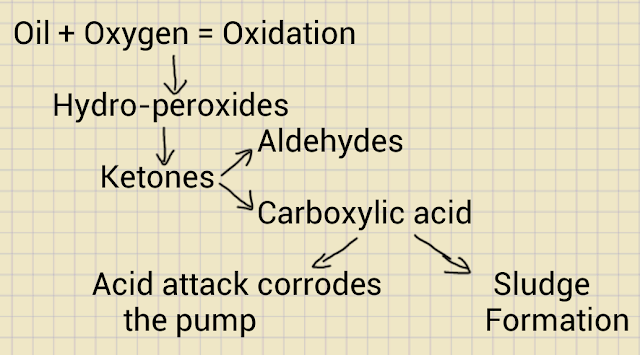In
the present time of cut throat competition, users are under great pressure to
reduce the cost of production. To achieve this objective, many times vacuum oils are not changed at specified intervals to get more “life” from them.
This
is a dangerous practice and can damage the vacuum system badly. Let us
understand why-
Oils
degenerate on account of oil oxidation. In Oxidation, oxygen reacts with the
oil to form Hydro-peroxides. Hydro-peroxides are unstable and break down into
Ketones. Ketones further oxidize to form Aldehydes and Carboxylic acid. Now
Carboxylic acid attacks the pump metal parts as well as O rings, Oil seals etc.
causing acid corrosion. That is not all. By products of oil oxidation in the
presence of acid further react and combine to form larger molecular species
which polymerize to form sludge.
Flow chart no. 1 - Degeneration of oil.
Sludge
makes oil very viscous and can cause –
·
Jamming and breakage of vanes
in the Rotary Vacuum Pump.
· Overheating and damage to the pump interiors in
the Diffusion Pump.
What
is even more damaging is that this process is like a nuclear chain reaction
that keeps speeding up with time. With oxidation, oil thickens and this reduces
lubrication, which in turn results in a higher temperature. At increased
temperature the rate of oxidation further increases (Rate of oxidation doubles
with every 100C rise of temperature as per Arrhenius rate
rule). This damages costly vacuum pumps in a short time.
Flow
chart no. 2 - Oil oxidation: chain cycle.
Oils
therefore must be changed as per specified schedule.
Note:
In this blog post I have explained the oxidation process of hydrocarbon/
mineral oils. In a different post, I shall explain how silicone oil
degenerates.
Written by: Anshuman Punj.







